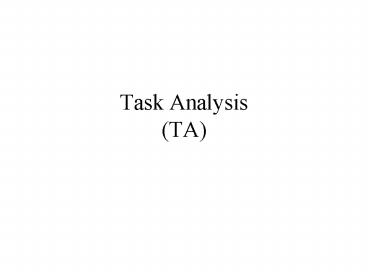Task Analysis (TA)
Title: Task Analysis (TA)
1
Task Analysis(TA)
2
TA GOMS
- Both members of the same family of analysis
techniques. - TA covers a wide area of study.
- Actual distinction between TA, GOMS and others is
what it aims to represent - Cognition of Task (GOMS)
- Practice of Task (HTA)
- Logic of Task (CCT)
3
GOMS
- GOMS analysis of human-system interaction can be
applied a various levels - The GOMS model, which describes the general
methods for accomplishing a set of tasks - The unit task level, which breaks users tasks
into unit tasks, then estimates the time that it
takes for the user to perform these. - Keystroke level, which describes and predicts the
time it takes to perform a task - Human Computer Interaction, Preece Page 419
4
TA GOMS
- GOMS - Cognitive task analysis is knowledge-
focused - Knowledge structures.
- Language.
- Cognitive/perceptual actions.
- Reveals internal representation and processing
associated with interface. - TA is behavior-focused
- What the user wants to do.
- What the user does do, applied to existing systems
5
Task Analysis - Whats a Task?
- A set of human actions that contributes to a
functional objective and to the goal of the
system. - Scope or size of a task is determined by the
definition of the objectives. - Each task should be approximately equal in size.
- But not always the case
6
Task - Decomposition
7
The difference is ...
- Goal - state of the system that a human wants to
accomplish. - Task - activities required, used, or deemed
necessary to achieve a goal. - Actions - steps required to complete the task.
8
(No Transcript)
9
Task Analysis vs...
- Engineering requirements analysis defines
performance required of hardware. - Programming specs define performance of software.
- Task analysis defines performance of humans.
10
(No Transcript)
11
Task Decomposition
- Aims
- describe the actions people do
- structure them within task subtask hierarchy
- describe order of subtasks
- describes existing systems
- Focus on Hierarchical Task Analysis (HTA)
- It uses
- text and diagrams to show hierarchy
- plans to describe order
12
Practical Task Analysis
- Develop concrete, detailed examples of tasks,
users perform or want to perform. - Determine what the user wants to do, not how to
do it. - No assumptions about interface ??????
- Allows design alternatives
- Task descriptions are very specific
- Task descriptions are context-specific
- Task descriptions are user-specific
13
Textual HTA description
- Hierarchy description ...
- 0. in order to clean the house
- 1. get the vacuum cleaner out
- 2. fix the appropriate attachment
- 3. clean the rooms
- 3.1. clean the hall
- 3.2. clean the living rooms
- 3.3. clean the bedrooms
- 4. empty the dust bag
- 5. put vacuum cleaner and attachments away
14
Plans
- ... and plans
- Plan 0 do 1 - 2 - 3 - 5 in that order. when the
dust bag gets full do 4. - Plan 3 do any of 3.1, 3.2 or 3.3 in any order
depending on which rooms need cleaning - Note only the plans denote order
15
Generating the hierarchy
- get flat list of tasks
- group tasks into higher level tasks
- decompose lowest level tasks further
- Stopping rules How do we know when to stop?
- Is empty the dust bag" simple enough?
- Purpose expand only relevant tasks.
- Error cost stop when P x C is small
- Probability of making an error X cost of the
error - Motor actions lowest sensible level
16
- Line under box means no further expansion.
- Plans shown on diagram or written elsewhere.
17
Refining the description
- Given initial HTA (textual or diagram)
- How to check/improve it?
- Some heuristics
- paired actions
- e.g., where is turn on gas'
- restructure
- e.g., generate task make pot'
- balance
- e.g., is pour tea' simpler than making pot?
- generalize
- e.g., make one cup or two ... or more
18
Redefined HTA For Making Tea
19
(No Transcript)
20
HTA Structure Chart Notation
21
Stages of a HTA
- 1. Starting the analysis
- a) Specify the main task.
- b) Break down main task into 4-8 subtask, and
specify in terms of objectives. Cover the whole
area of interest - c) Draw out as layered plans, logically
technically correct. None should be missing.
22
- 2. Progressing the analysis
- a) Decide on level of detail and stop
decomposition. Should be consistent between
tasks. Can range from detailed to high level
description. - b) Decide if a depth first or breadth first
decomposition should be done. Can alternate
between the two. - c) Label and number the HTA.
23
- 3. Finalizing the analysis.
- a) Check that decomposition and numbering is
consistent. May produce a written account of the
processes. - b) Have a second person look it over. They should
know the tasks but not be involved in the
analysis.
24
(No Transcript)
25
(No Transcript)
26
Assumptions about the interface
- Must be made to fulfill the system requirements.
- Very true if we are describing how users behave
on an existing system. - Should not be made when we are designing a new
system. - Dont limit our options before we start.
27
The End































